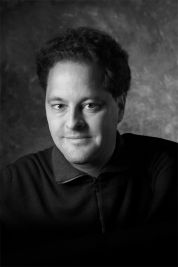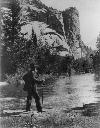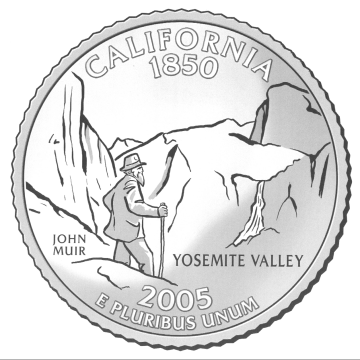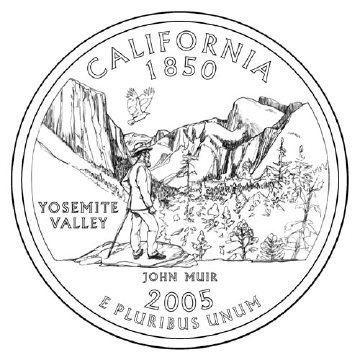the john muir exhibit - state quarter - garrett burke
John Muir-Yosemite California State Quarter
 |
Garrett Burke
Photo by Tom Keller |
About the Concept Designer
Garrett Burke
For Garrett Burke, his California State Quarter journey has been, in his words, "the most satisfying creative effort of a long graphic design career."
In June, 2002, Garrett was at the Long Beach Coin Show with his wife, Michelle and young daughter. His wife has been a coin collector, or numismatist, since she was seven years old. She handed him a brochure soliciting designs for the California Quarter. After two months of Michelle's gentle arm-twisting, he opened his sketchbook and on Sunday, September 7, got to work.
Garrett says, "It was my wife who really urged me to contribute something. I'd always felt that coins had a kind of spiritual value to them, but she was the one who showed me the artistic value." As an artist and designer, Garrett learned about the artistic value of coins, but was also interested in their historic and educational value. Garrett says that all the same essential principles that apply to art hold true with coins. He says:
"A coin is really a very small piece of sculpture. It has monetary value, of course, and value to the government as currency, but also some intrinsic value that has to do, in part, with who or what scene is depicted on the face - or, in this case, the reverse - of the coin."
An honors graduate of Pratt Institute School of Art and Design in New York,
he moved to Southern California in 1985. Garrett is a 42-year-old designer
creating movie posters, logos, art and brochures for the entertainment industry.
Clients include Warner Bros., 20th Century Fox, Lucasfilm, Sony, Nickelodeon,
Disney, Mattel, Microsoft, Activision, XBOX, and the American Humane
Association. He's worked with some of the biggest names in show business,
including James Bond, Darth Vader, Harry Potter, Dr. Seuss, Spider-Man and Superman. An award-winning designer, Garrett's work has been recognized by Graphis Design, Print's Regional Design Annual, American Corporate Identity and numerous design books.
Garrett lives in Los Angeles, but isn't a native Californian, having grown up
in suburban Philadelphia. He spent two years at Millersville University in
serene Pennsylvania Dutch Country before attending Pratt Institute in New
York City. He says, "While in Lancaster County, I daily witnessed Amish and
Mennonite farmers working and respecting their farmlands. I often rode my
bike throughout the picturesque Conestoga Valley near the Susquehanna River
and developed an appreciation of local folk art."
After college graduation in August 1985, he came to LA in search of youthful
adventure and career goals. "The State Quarter Program motivated me to give
back to California a small expression of my respect for what the state has
given me... a livelihood, wife and daughter." Excited by the wealth of images associated with the state, he worked early mornings, late nights and weekends, drawing up some 15 different design concepts for the California Quarter while juggling demanding deadlines at an ad agency job. There was a tremendous amount of research that went into the project. He spent a good deal of time reading about California history and studying California imagery and symbolism, checking out books from four local libraries. Garrett said, "What I really learned was how much I didn't know."
Early on he began to focus on Yosemite, because of his love for the outdoors.
He said:
"At first, I simply had Yosemite Valley on the coin, but then I thought it lacked a person, lacked a story. The coins that had always appealed to me personally were ones that had a person on them. Particularly when the person is neither a president nor royalty, I find I want to know more about them, what made them worthy of such an honor. The gold dollar with Sacajawea, for example, or the figure on the Standing Liberty Quarter. You know, each coin is really a little piece of American history. I didn't know anything about Caesar Rodney until I saw him on the Delaware Quarter and learned about his famous horseback ride to sign the Declaration of Independence. When I thought about it, it was like, 'Wow, I just learned a little bit about my country.'
For my design, I wanted someone who represented something that I, as a citizen, could aspire to. And I thought, wouldn't it be great to have someone from California who would inspire and educate people? John Muir just rose to the front of my mind immediately."
Burke says Muir is someone that Californians should be proud of.
"He was the originator of grassroots efforts to preserve nature," he says. "Educating kids about John Muir was the whole impetus to submit the quarter in the first place.
It turned out that Garrett's John Muir-Yosemite design was only one of more than 8,000 designs for the new quarter submitted by the public between September 2002 and November 2002.
Of these 8,000, the California Quarter Selection Committee then narrowed the
list to twenty. On December 31. 2002, these were posted on Gov. Gray Davis'
Web site and Californians were encouraged to vote for their favorite design
in a non-binding poll online. Most of California's well-known icons were depicted:
the California grizzly, the Golden Gate Bridge, gold mining, the motion picture
industry, the giant Sequoia and other trees, farming, mountains and other natural
resources. Many of these were combined in various collages. Garrett at that
time said he felt very honored just to be chosen among the top 20. Like many
other designers, he didn't hesitate to spread the word about his design, pointing
people to the website to make their favorite selection.
Garrett's concept was mindful of the Mint's design guidelines, which prohibit featuring the head or bust of any person, living or dead, but does allow other representations of people. Already, the 1999 Delaware coin features Caesar Rodney on horseback, North Carolina's 2001 design included the Wright Brothers with an airplane, while Louisiana's 2003 coin features Helen Keller reading a book in braille. Yet, most State Quarters so far seem to feature traditional representations of the state, including outlines of the state map, statues, state-houses, agricultural products, and state flowers and trees.
Garrett also kept in mind the Mint's requirement for "coinability." Remembering that the final result would be more like a bas-relief than a drawing, he tried to anticipate what the stamp-and-die metal finish would look like. Garrett felt his limited knowledge of the minting process was unimportant as the U.S. Mint's artisans would rerender the selected concept and their expertise should be the final word for all stages of the process. "I'm a 2-dimensional graphic designer, not a sculptor," he said, "but my Pratt classical art education of figure drawing and 3-dimensional form was extremely valuable in imagining a proper coin."
 Garrett's submitted concept depicted Muir in a pose taken from a photograph of Muir in Yosemite standing beside the Merced River, with Royal Arches and the Washington Column in the background. Garrett changed the background to include a full representation of Yosemite Valley, including El Capitan, Half Dome, and Bridal Veil Falls, as if Muir was standing at Inspiration Point:
Garrett's submitted concept depicted Muir in a pose taken from a photograph of Muir in Yosemite standing beside the Merced River, with Royal Arches and the Washington Column in the background. Garrett changed the background to include a full representation of Yosemite Valley, including El Capitan, Half Dome, and Bridal Veil Falls, as if Muir was standing at Inspiration Point:

He had not yet been to Yosemite before submitting the concept. Two previous
family trips were postponed. Garrett says he instead imagined the natural
beauty of Skywalker Ranch in Marin County, a place he had visited several times
while working on Star Wars projects.
In March of 2003, Garrett's concept was selected as one of five semifinalists by then-governor Gray Davis. The other concepts included: Golden Gate Bridge collage by Sarah Bailey of San Diego, the Gold Miner collage by David Biagini of San Francisco, Waves and Sun by James M. Cody of Weed, and the Giant Sequoia by Jonathan Louie of San Diego. The latter design wasn't among the top vote-getters in the online poll, showing that the Governor was interested in selecting from among a variety of designs without it being purely a popularity contest.
That fall, Governor Davis was replaced by Arnold Schwarzenegger as Governor in an unprecedented recall election. Then, later in 2003, the U.S. Mint returned a revised version of several images, including this version of the John Muir-Yosemite design, adding both more detail to the image, plus a California Condor flying in the sky:

Garrett was unfazed by the changes made in the design. While he thought this second design was a bit complex, he appreciated the attention to detail. But later it appeared Governor Schwarzenegger agreed, because we learned that he asked the U.S. Mint to simplify the design.
The Mint did revise the design, and Garrett's John Muir-Yosemite concept was ultimately selected by Governor Schwarzenegger:
The unveiling ceremony was held March 29, 2004 at the California State Library. Garrett, like the other five designers, was told a few days before that the announcement would be made that day, but was told that at this point only that he simply had a 1 in 5 chance of being selected, along with everyone else. He didn't find out that his design concept was chosen until after the news media did!
On the day of the announcement Garrett was left speechless when informed by a reporter for the San Jose Mercury News that his concept had been chosen for the California State Quarter.
"Oh my god," Burke said in a telephone interview as his wife, Michelle, yelped in delight in the background. "Wow!"
When he regained his composure, Garrett told the paper, "It's not about who designed the quarter. It has to do with nature, John Muir, the environment and educating children."
What does Garrett think of the final design, which differs quite a bit from his original? He says, "Being an art director and having worked with some of the
entertainment industry's very best illustrators, I can tell that tremendous
artistry went into this rendering...one of the Mint's finest of the 50 State
Quarters Program."
"In my opinion, the final image is wonderfully iconic, soulful and respectful
of California's heritage as a land of great natural beauty where each citizen
has an important voice. Particularly welcome are Governor Schwarzenegger's
requested revisions to my original submission concept. The Governor's addition of the California Condor is something I believe John Muir himself would have
loved. Sensitivity is given to the rocky outline around the Yosemite Valley
typography and the carefully crafted silhouetting of Muir, soaring condor and Half Dome. The image tells a big story that will be impressive at reduced coin size."
Even after dozens of radio and newspaper interviews, Garrett remains focused on the message he hopes to bring to people:
"I want people to realize that we have to learn to coexist with nature, that nature is precious and that man's place in nature should never be taken for granted. And that one person can make a difference. What Muir stood for is really what all Americans, and really all citizens of the planet, should stand for: Making a difference and living in balance with nature and just realizing that we're only on this planet for a very short time and that what we do every day counts.
"John Muir embodied that spirit. He had no boundaries. Everything in his life was about searching, about educating himself and inspiring others. I told my wife he was like the Johnny Appleseed of conservation. He planted the seeds of his message everywhere. And that message was so pure and his passion so profound, that people would listen."
"When someone looks at the back of that quarter, I want them to say either: 'John Muir, what a great guy, I love his message,' or: 'Who's John Muir? I need to find out more about him.' That's the thrill for me, knowing that it's educating people."
Contact Information:
Garrett Burke
muirquarter@aol.com [EMAIL]
www.garrettburke.com [WEBSITE]
Garrett Burke's TV Interviews and Public Speaking - Learn more about the California State Quarter.
Book: Quarterama: Ideas and Designs of America's State Quarters by Garrett Burke
310-488-6723
PO Box 996
Palos Verdes Estates, CA 90274
Home
| Alphabetical Index
| What's New & About this Site